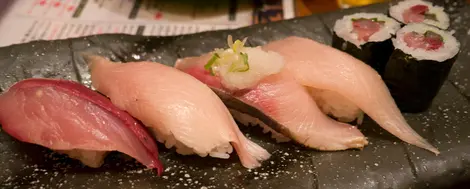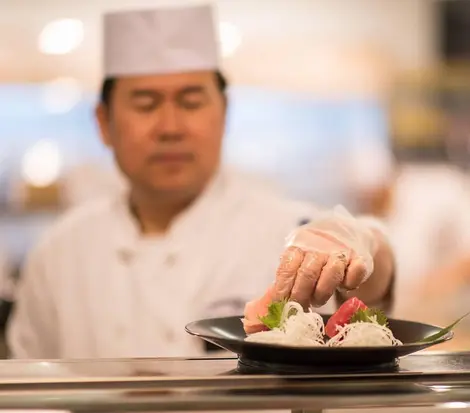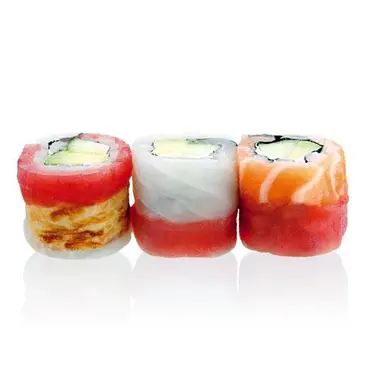Sushi 寿司
- Published on : 31/01/2018
- by : A.R.
- Youtube
The Japanese cultural emblem
Sushi restaurants are multiplying in France, and the consumption of sushi has almost become second nature among our fellow citizens. However, sushi, the spearhead of Japanese culture abroad, remains an expensive and luxurious dish reserved for special occasions.
A history of sushi
Originally from Southeast Asia, the concept of the ancestor of sushi has spread, reaching as far as China. It was the Chinese who, in the 5th century BC, invented the first technique for preserving fish. This was salted and then covered with rice: the fish was then preserved from rotting, and could be kept for several months. If this technique quickly disappeared from the country, the Japanese, big fish consumers, reused and adapted it. Thus, the Japanese living inland could also eat fish via what was then called narezushi , several days or even months after fishing. Later, the namanare was invented : the fish, raw, is again coated in rice. However, it is no longer really a question of preserving the fish but of consuming it differently, with a new recipe.
To read: Rice vinegar
A third version of sushi emerges, the haya-zushi , which this time allows the consumption of fish and rice at the same time, the rice having previously been vinegared and mixed with vegetables. But it was not until the beginning of the 19th century that sushi proper appeared for the first time, the international star of Japanese gastronomy. Edo, the future city of Tokyo, is booming. Yatai , ancestors of food-trucks, take over the streets and offer fast and easy-to-eat food. Hanaya Hohei then creates the nigirizushi : a small ball of vinegared rice, topped with lightly marinated raw fish, the techniques of refrigeration still not being at the forefront. The nigirizushi is spreading in the city! It was unfortunately following the earthquake of 1923, and the dispersion of the surviving chefs in the country, that sushi would become a national hit.
From 3 star sushi to 100 yen sushi
The government ends up banning these cheap sushi stands, and it is then that the discreet but luxurious restaurants make their appearance: the ryotei. Businessmen and politicians met there in the company of geisha, and consumed sushi at all costs until the end of the 20th century. Today, any citizen, with a well-filled wallet, can access this kind of restaurants, which sometimes even have Michelin stars.
It was chef Jiro and his restaurant in Ginza, immortalized in the documentary "Jiro Dreams of Sushi" , who paved the way: he was the first restaurant serving exclusively sushi to win three stars from the famous guide. Of course, not everyone can afford a Michelin-starred restaurant, but don't panic: everywhere in Japan you will find sushi suitable for all budgets. Kaitensushi restaurants have even developed there , or "rolling sushi", the particularity of which is that the sushi rolls on a conveyor belt. Very popular because of the fun aspect of the service, these restaurants are also very accessible: 100 yen a pair! If the quality is not the same as that of more high-end restaurants, it will be noted that these sushi are good value for money.
Read : Kaitenzushi
Sushi, infinite variations
While high-end restaurants focus exclusively on sushi in its most traditional form, a ball of rice topped with fish or a raw shrimp, or even an omelette , that hasn't stopped sushi from be available in many forms: makizushi , fish surrounded by rice and a sheet of nori seaweed, temakizushi, a cone of nori filled with vinegared rice and fish,chirashizushi , a bowl of vinegared rice topped with several slices of raw fish, inarizushi , fried tofu filled with vinegared rice… Thus, depending on the region and the season, you will find local specialties all over Japan.
Read also: Ajigin, inari-zushi specialist
But the process of variation does not stop there: from the 1980s, sushi began to be exported. And who says export says rehabilitation! Indeed, if it is now possible to consume sushi anywhere in the world, and these have evolved according to the country. Its best-known adaptation remains the California Maki , through which sushi succeeded in conquering the Americas. Be careful, it is almost impossible to find in Japan. Similarly, the avocado is far from being a preferred ingredient in the production of traditional sushi.
Discover: The Kakinoha-zushi of Nara
In France, Japanese restaurants often offer menus combining sushi and yakitori , which would be unthinkable in Japan. The nori sheet can also be replaced with cucumber or lettuce. The Koreans developed the kimbap , highly inspired by Japanese maki. We can also add all the variants from so-called fusion cuisine, which means that, even today, sushi is available in all possible and unimaginable forms , with or without fish and salty or sweet.
Tasting Japanese sushi is an essential part of a trip to Japan: it's up to you to find the one you like the most! Enjoy your lunch !
For further :
- The profession of sushi chef in Japan
- Japanese noodles
- Wagashi, Japanese pastries
- Culinary specialties of Okinawa

















